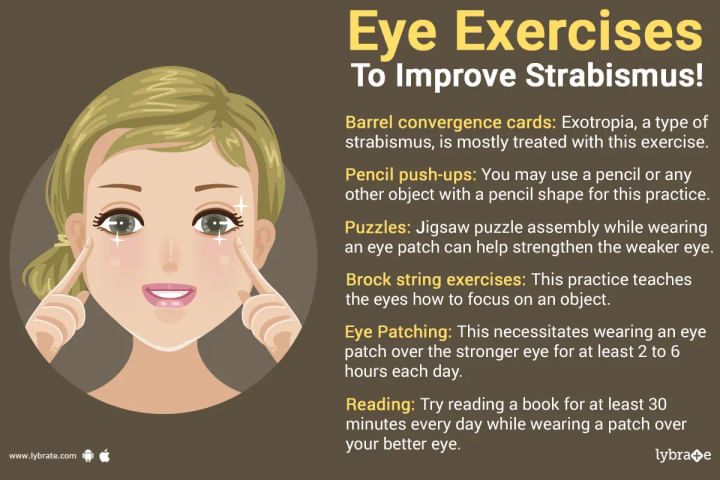Eye Exercises for Strabismus
What is Strabismus?
Strabismus is an eye condition in which the eyes do not line up in the same direction. In this condition, one eye could turn inward, outward, upward or downward while the other eye looks forward. Strabismus can occur in any age group and is usually first noticed in children before the age of five.
It is estimated that 4-5 percent of children have some form of strabismus. If left untreated, the brain may begin to favour one eye over the other and permanent vision loss can occur.
What are the signs and symptoms of Strabismus?
- A noticeable misalignment of the eyes, with one eye pointing in a different direction than the other.
- Poor depth perception, as seeing two flat images instead of a single three-dimensional one.
- A 'cross-eyed' or 'wall-eyed' appearance, with both eyes looking inward or outward simultaneously.
- An inability to focus on close objects or to maintain clarity at a distance.
- Double vision in one or both eyes caused by constant struggling between the two eyes trying to focus on separate objects at the same time.
- Chronic headaches and eyestrain due to straining both eyes in an attempt to keep them focused on the same point at once.
- Squinting, blinking, or making funny faces while reading and trying other methods of keeping both eyes in alignment for better vision outcomes.
What are possible complications of Strabismus?
Possible complications of Strabismus include:
- Amblyopia: Reduced vision in one or both eyes due to lack of use or stimulation caused by strabismus.
- Reduced Visual Acuity: The loss of sharpness in vision due to strabismus, which can lead to difficulty recognizing objects and people from a distance.
- Double Vision: Having two images overlapping one another due to misalignment of the eyes caused by strabismus, leading to disorientation and confusion.
- Difficulty with Eye Movement Coordination: Problems controlling eye movements may lead to difficulty reading, tracking moving objects, playing sports and participating in other activities that require precise coordination between the eyes and the brain
- Loss of Binocular Vision: The decrease in depth perception due to the lack of coordination between both eyes may reduce field depth awareness, resulting in impaired visual spatial perception and decreased mobility while navigating in areas with unfamiliar terrain or obstacles
- Psychological effects: Often children with strabismus face social stigma that affects their self-esteem; additionally, adults may experience anxiety over their appearance or abilities associated with this condition.
Eye Exercises for Strabismus
Strabismus, or crossed eyes, is an issue that can be corrected with eye exercises. Eye exercises aim to strengthen the muscles around the eyes and help improve alignment of the eye itself. Here are some exercise suggestions for those living with strabismus:
- Palm Push: This exercise involves pressing your palms against your closed eyes for 15 seconds. Then release the pressure, open your eyes, and repeat 10 times a day. This exercise helps strengthen the eye muscles by pressing against them when they are at rest.
- Eye Circles: Close both eyes then trace circles in the air with them for five minutes per day. Move both eyeballs slowly around in small, counterclockwise circles first and then another set of small clockwise circles to help relax the muscles in and around your eyes as well as improve their focusing ability as you track motion with them again.
- Blink Reflex: This exercise requires you to blink while counting! Inhale through the nose while blinking 10 times very slowly before exhaling through pursed lips—this helps increase oxygen flow to the brain which can improve concentration and focus that often accompany strabismus conditions.
- Rocking Chair Exercise: This exercise helps strengthen your focusing ability by rocking back-and-forth between two objects placed 10 feet away from each other on either side of a doorway or other space allowing you access to it every day—first begin by focusing completely on one object until it becomes blurry then switch focus between that and another object within line of sight a couple times before repeating on opposite direction twice more per session (aim for seven sets total during each time).
- Focus on Objects Closely: Find an interesting object (like a pen or pencil) approximately six inches away from you that stands out against its background (i.e On a white page). Gaze at it long enough so that it becomes blurrier and harder to make out—this helps work out both ocular muscles together which might help reduce double vision episodes due to strabismus!
By regularly performing these exercises, individuals living with strabismus should be able to improve their eye alignment over time and provide great relief from vision issues caused by misalignment of the eyes. Surgical intervention may be necessary if other methods do not help.
What are the surgical treatments for Strabismus?
- Adjustable Sutures: Adjustable sutures are a minimally invasive surgical procedure in which tiny stitches are placed in the eye muscles to strengthen or weaken them, thereby addressing the underlying cause of strabismus.
- Recession-Resection Surgery: This type of surgery involves altering the length of eye muscles that connect to the eyeball by either removing a small section (resection) or weakening them by pushing them backward (recession). The aim is to restore normal eye alignment and tracking.
- Harada-Ito Procedure: This procedure is typically used to treat horizontal misalignment and involves shrinking one eye muscle while stretching another, modifying their characteristics so they pull more evenly on each side.
- Tenotomy/Tendon Hangback: During this procedure, an ophthalmologist will cut two tendons that have become short and tight over time, usually as a result of trauma, causing misalignment of the eyes; once cut, these tendons can be reattached further back on the eyeball with permanent sutures, allowing for improved muscle balance and better visual alignment between the eyes.
- Botox Injections: Botulinum toxin (or Botox) injections can be used to temporarily relax overactive eye muscles and reduce swivel or crossing in strabismus patients; this technique is usually employed for intermittent squinting episodes or after failed surgical treatment attempts when adjusted sutures cannot be utilised.
Best doctors to consult for Strabismus
- Ophthalmologists: When considering which doctors to consult for strabismus, Ophthalmologists are the best choice due to their specialised training and focus on eye health.
- Paediatric ophthalmologists: They specialise in the diagnosis and treatment of strabismus in children, while adult ophthalmologists can provide more specialised care for adults with strabismus.
- Neuro-ophthalmologist: For individuals who need therapeutic interventions such as muscle transfers or injections, a neuro-ophthalmologist or paediatric neuro-ophthalmologist may be the best fit due to their expertise in neurological and eye diseases specific to children.
Other specialists that may be consulted for strabismus include vision rehabilitation therapists who can provide exercises or therapies to improve eye alignment, vision therapy specialists for improved visual performance, orthoptists who are trained specifically in eye misalignment disorders, and optometrists who provide eyeglasses and contact lenses that correct refractive errors related to strabismus.



+1.svg)
